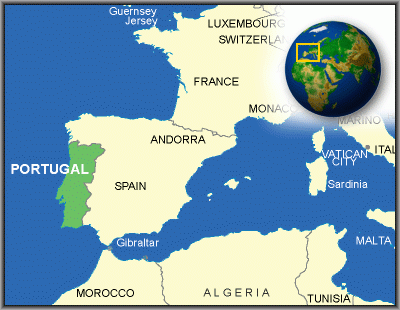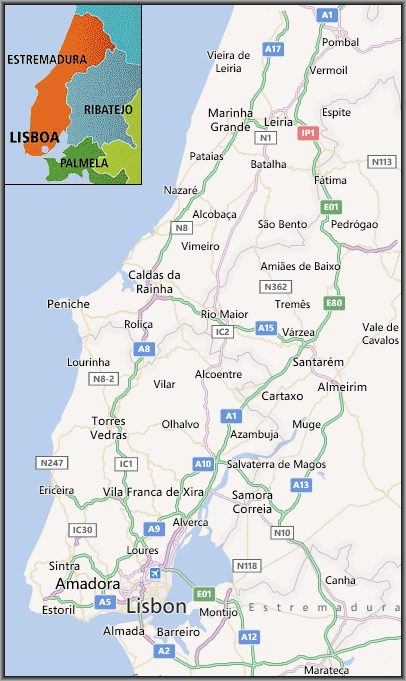
Setup & config options
Suitable power supply
RasPi & sFTP file transfer
Home network print server
Home network scan server
Mesh : home Lan USB drive
Explore hard & software
UFW firewall explained
Secured by fail2ban server
Software packaging & PPA
Apache 2.4+ LAMP server
https web server : port 443
Varnish caching proxy
Module : cgi & perl
Module : geoip
Modules : php & mysql
http*s error handling
Server : conditional logging
TL-domain & dynamic DNS
Webalizer log analyser
Defeat referrer spam
robots.txt & xml sitemaps
Server : .htaccess handling
The game & not the islands
Setup & config options
North Atlantic : Macaronésia
🚫 No ads & tracking
Portugal - The portuguese Estremadura
The snapshot to the portuguese Estremadura
This is an older article which I wrote on a free subdomain provided by Wordpress many years ago.
11-Dec 2018

Estremadura overview
Estremadura is a land of contrasts. The Atlantic crashes upon the southern coast, but farther up, it can hardly muster a ripple in the snug cover of São Martinho do Porto. East of the flat seascapes of the west are two mountain ranges. But the presence of the nearby sea is evident throughout Estremadura. Even in the many examples of Manueline architecture, especially at Batalha, the tie with the sea remains unbroken. Its nautical designs - ropes, cables, armillary spheres, and seascape effects - reflect Portugal’s essential connection to the sea.
Estremadura contains lovely towns as old as Portuguese nationhood whose beauty has not been diminished by time. Despite the name, the region is neither extremely harsh nor especially remote. Rather, it is in many ways the spiritual heart of Portugal. Its isolation derives more from the slow, erratic, and sometimes undependable public transportation, which makes the region best suited to a driving tour.

Overview map Estremadura

Regional attractions
Óbidos : 93 km North of Lisbon, 7 km South of Caldas da Rainha. The town is definitely a trip back in time. The medieval city rises on a sugarloaf hill above a valley of vineyards. Its golden towers, crenellated battlements, and ramparts (which afford views of Estremadura) contrast with gleaming white houses and the rolling countryside, where windmills clack in the breeze.
In the Renaissance church Igreja de Santa Maria, blue-and-white azulejos (tiles) line its interior. The church lies to the right of the post office in the central square. The other major attraction in Óbidos is the castelo. The castle suffered severe damage in the 1755 earth-quake but was restored. It’s one of Portugal’s greatest medieval castles, with a host of Manueline architectural elements. The main entrance to Óbidos is a much-photographed gate, the narrow, zigzag Porta da Villa.
Ideal for general sunning and swimming is the beach at Lagoa de Óbidos, northwest of Óbidos and west of Caldas da Rainha. Windsurfing boards and rigs can be rented on the beach here; surfers generally prefer the beach at Peniche, southwest of Lagoa de Óbidos, because the waves are better there.
Alcobaça : 108 km North of Lisbon, 16 km North-East of Caldas da Rainha. The main attraction in Alcobaça is its stately monastery. Also explore the nearby market, said to sell the best fruit in Portugal. The peaches, grown in surrounding orchards originally planted by the Cistercian monks, are especially succulent. Many stalls also sell the blue-and-white pottery typical of Alcobaça.
The area around Alcobaça contains two of the least discovered but most dramatic havens for nature in Portugal: a national park and an offshore island that’s ideal for scuba diving.
Parque Natural das Serras de Aire e Candieiros straddles the border between Estremadura and Ribatejo, almost halfway between Lisbon and Coimbra. Encompassing more than 30,000 hectares of moors and scrubland, the rocky landscape is sparsely settled. A centre for hikers is the small hamlet of Minde, where women weave patchwork rugs that are well known in the region.
The other great area of natural beauty is Berlenga Island. A granite rock in the Atlantic, Berlenga is an island hideaway and nature preserve. 11 km out in the ocean west of Peniche, a medieval fortress once stood guard over the Portuguese coastline from this island. Berlenga is the largest island in a little archipelago made up of three groups of rocky rises known as the Farilhões, the Estelas, and the Forcades. The medieval fortress on Berlenga, Forte de São João Batista, was destroyed in 1666 when 28 Portuguese tried to withstand a force of 1,500 Spaniards who bombarded it from 15 ships.
Nazaré : The inhabitants of Portugal’s most famous fishing village live in a unique, traditionbound world that tourists threaten to overthrow. Many residents have never left their village, except perhaps to make the pilgrimage to nearby Fátima. The people remain insular, even as their village blossoms into a big summer resort. Nazaré is probably best experienced in the off season; chances are that you won’t really get to see it in summer. The crowds who come to visit the most picturesque fishing village in Portugal, coupled with widespread high-rise construction, have made people wonder what happened to the fishing village.
Nazaré consists of two sections: the fishing quarter and the Sítio, the almost exclusively residential upper town. Near the beach you’ll find handcraft shops, markets, restaurants, hotels, and boardinghouses. The main square opens directly onto the sea, and narrow streets lead to the smaller squares, evoking a medina in a Moorish village. At the farthest point from the cliff and square are the vegetable and fish markets, where auctions are held.
Jutting out over the sea, the promontory of the Sítio is a sheer drop to the ocean and the beach below. It’s accessible by either a funicular or a steep cobblestone path-way.
Batalha : 118 km North of Lisbon. Batalha merits a visit for only one reason: to see the monastery. Most visitors choose to stay in Fátima or Nazaré, which have more hotels and restaurants. However, there are places to sleep and eat in Batalha.
Fátima : 142 km North of Lisbon, 58 km East of Nazaré. Fátima is a world-famous pilgrimage site because of reported sightings of the Virgin Mary in the early 20th century. The terrain around the village is wild, almost primitive, with an aura of barren desolation hanging over the countryside. However, when religious pilgrims flock to the town twice a year, its desolation quickly turns to fervent drama.
The beaches in Estremadura : Costa Prata
Take your pick from the ribbonlike string of beaches that stretches almost continuously along the coast of Estremadura. Some 240 km of sand extend all the way to its northern edge, just south of the beach resort of Figueira da Foz.
Many of Estremadura’s beaches are uncrowded and filled with powdery sand bordering crystalclear waters. Others, especially those near industrial wastelands, are much less desirable and might be polluted. Look for beaches flying a blue banner, which indicates that the European Union has ranted its seal of approval to the beach’s hygiene and safety. The seaside village of São Martinho do Porto, 116 km north of Lisbon and a short run south of overcrowded Nazaré. This resort nestles between pinecovered foothills and the ocean, and its waters are calm and clear. Another good beach, north of Nazaré, is at São Pedro de Moel, 135 km north of Lisbon.
Another place worth seeking out is the town of Peniche, 92 km north of Lisbon. This fishing port stands high on a peninsula, with wide, sandy beaches at the foot of rocky cliffs. It doesn’t always have the cleanest water, but it is nevertheless a family favourite. When you tire of the beach, you can explore Cabo Carvoeiroon the peninsula, about 5 km east of Peniche. It offers panoramic views of the surf smashing against the rock formations hundreds of feet below the road.
Other less frequented but good beaches are at Pedrogão, Baleal, Consolação, Porto Covo, Porto Dinheiro, and Santa Cruz. All are signposted from the highway.
Many of the most popular beaches, those with the most facilities, are frequented for their sands. They might not have blue flags, depending on conditions, when you visit. These include Milfontes, Foz do Arelho, and Nazaré. When red flags are up, beach buffs don’t go into the water but still flock to the sands for sunning. These beaches are always for sunning, but only for swimming when blue flags are flying.




